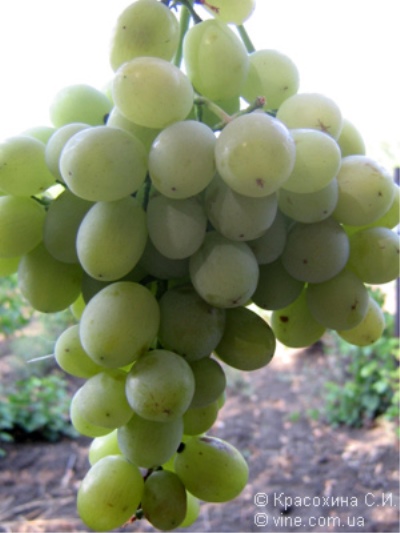
- Authors: Dagestan
- Appointment: dining room
- Berry color: light greenish-yellowish with a yellowish-pink tint on the sunny side, covered with a middle layer of pruin
- Taste: simple, tart, mediocre
- With bones: Yes
- Ripening period: mid-late
- Ripening period, days: 138-160
- Frost resistance, ° C: -23
- Name synonyms: Derbent Tsibil
- Bunch weight, g: 800
Growing grapes in your garden is as easy as growing any other fruit, if you follow the recommendations of the experts. The Agadai variety is an excellent solution for those who are just beginning to learn the art of viticulture. It is appreciated for its remarkable properties and amazing taste.
Breeding history
This variety appeared on the territory of Dagestan, from there it was distributed throughout the world. In 1959 it was approved for use.
Geography of distribution
Agadai is zoned on the territory of Crimea and Odessa region. Today, this grape can be found in the south of our country and not only.
Description
The table variety has bisexual flowers, which means it does not require pollination. This is a vigorous bush. Pruning is a prerequisite for quality cultivar care.
In young plants, the foliage is smooth, has a green tint with a bronze tint. The foliage has five lobes. Young shoots are yellow, on the nodes the color is more intense.
Ripening period
The Agadai variety belongs to the middle late ripening period. From the moment of bud formation to full ripening of the fruit, it takes 138-160 days.
Bunches
The bunches have a cylindrical-conical shape. The bunches are of medium density. Weight is about 800 grams.
Berries
The berry of this variety has a complex shade, it can be described as light green-yellow with a pink tint where the sunny side is. There is a layer of spring on the surface.
There are seeds inside, in one grape there can be from three to 5 pieces. The skin of the fruit is medium in density, it is poorly separated from the crunchy and slightly juicy pulp. The grapes are oval in shape, some may be oblong. The weight of one fruit varies from 6 to 8 grams.
Taste
Tasters describe the taste of this grape as simple, slightly tart and even mediocre, but this does not diminish its popularity in any way.
Yield
This indicator is at the level of 100-130 c / ha and can even exceed this indicator with high-quality care.


Growing features
Grapes are a hardy plant that can be grown outdoors. It must be cut off after planting to two buds. They should be left on the shoot in opposite directions along the trellis.Each subsequent year, old / dead shoots are pruned to leave room for the strongest.
Landing
For planting grapes, it is advisable to choose a sunny southern location with loamy, fertile soil and very good drainage. A distance of up to 1 meter from bush to bush is noted, a trellis post is installed in each place.
Digging a hole. It is important to estimate its size. For the root system of the vine, it should be twice as large as the existing roots of the seedling. Place the vine in the hole, spread the roots, and cover it with earth until it is three-quarters full. Now they tamp down a little, water and report the soil to the root collar.

Pollination
There is no need for pollination, since the variety is self-pollinated.
Pruning
The main purpose of pruning in the first year is to get the root system to develop and strengthen. Therefore, remove all flowers that develop on the vine so that the plant can focus on root development. All shoots are cut off, except those that will bear fruit in the future. It is best to choose 1-3 strong vines in the future to form a bush.

Watering
Water is added to the soil as needed. New plants need more fluid than established vines. Water the soil weekly during the first year, especially during hot / dry periods, then the amount of watering is reduced.


Top dressing
Both mineral and organic fertilizers can be used as top dressing. In the first case, it is not difficult to determine the choice; there is a large selection of such mixtures on the market. In the case of organic matter, it is worth using rotted manure, wood ash or bird droppings. They are diluted with water and watered around the plant, but not on the root system, as this can burn it.
Frost resistance and the need for shelter
The need for shelter arises when grapes grow in a region where the air temperature can drop below -23 degrees. Experienced gardeners use spruce branches or a special material to cover the vine. Before that, it is removed from the trellis and laid on the ground.

Diseases and pests
Agadai has poor resistance to mildew, powdery mildew and gray rot, so it must be treated with fungicides. Insecticides help with insects.

If a grape is exposed to any disease or insect, this always affects its appearance.
Storage
Berries of this variety are perfectly transported, and at the same time their presentation does not deteriorate. Under special conditions, grapes can be stored for up to three months.











































































